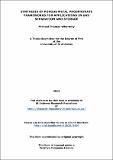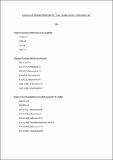Files in this item
Synthesis of porous metal phosphonate frameworks for applications in gas separation and storage
Item metadata
| dc.contributor.advisor | Wright, Paul Anthony | |
| dc.contributor.author | Wharmby, Michael T. | |
| dc.coverage.spatial | 297 | en_US |
| dc.date.accessioned | 2013-03-29T10:33:59Z | |
| dc.date.available | 2013-03-29T10:33:59Z | |
| dc.date.issued | 2012-05-22 | |
| dc.identifier | uk.bl.ethos.569016 | |
| dc.identifier.uri | https://hdl.handle.net/10023/3450 | |
| dc.description.abstract | Porous metal phosphonate framework materials were synthesised by solvothermal reaction of bis(α-aminomethylenephosphonic acid) ligands with divalent and trivalent metal cations. The syntheses and characterisation by NMR and, where possible, single crystal X-ray diffraction of seven bisphosphonic acid ligands, including N,N′-piperazinebis(methylenephosphonic acid) (H₄L), its racemic and enantiopure (R) 2-methyl (H₄L′ and R-H₄L′) and 2,5-dimethyl (H₄L′′) derivatives, and N,N′-4,4′-bipiperidinebis(methylenephosphonic acid) (H₄LL) are reported. Syntheses of the known phase Y₂(LH₂)₃·5H₂O and the new phases, STA-13(Y) (St Andrews microporous material No. 13) and Y₂(R-L′H₂)₃·4H₂O, from reactions of Y(AcO)₃ with H₄L, H₄L′ and R-H₄L′ respectively are reported. The as-prepared and dehydrated structures of each phase have been determined from either laboratory or synchrotron powder X-ray diffraction data. Reaction of Y(AcO)₃ and H₄L′′ is shown to form a phase with a different structure. The features determining which structure crystallises are discussed. Syntheses of other rare-earth forms of STA-13 (Sc³⁺, Gd³⁺–Yb³⁺) and the porosity of each phase to N₂ are reported. STA-13(Y) is the most porous form with loadings of ∼3 mmol g⁻¹ and ∼4 mmol g⁻¹ for N₂ and CO₂ respectively. MIL-91(Fe) was synthesised for the first time from reactions of Fe³⁺ cations with H₄L. Its structure was confirmed by Rietveld refinement, but it was not porous. The first syntheses of [Fe₄L₁.₅(AcO)₁.₅(OH,H₂O)₃]·0.5NH₄5.5H₂O (L= L or L′) are reported, from reactions of H₄L or H₄L′ in the presence of an excess of Fe³⁺ cations. The phase is related to a previously reported Co phase. The synthesis of divalent metal bisphosphonate STA-12(Mg) (Mg₂(H₂O)₂L·5.6H₂O) was reported for the first time and its structure determined from single crystal X-ray diffraction. The dehydration behaviour of this material was compared with the known forms of STA-12. STA-12(Mg) is porous to both N₂ (∼5.5 mmol g⁻¹) and CO₂ (~ 8.5 mmol g⁻¹). Reaction of H₄LL with Co²⁺ and Ni²⁺ gave two materials isoreticular with STA-12, labelled STA-16(Co) and STA-16(Ni). The structures of both materials were solved from synchrotron powder X-ray diffraction data. On dehydration, STA-16(Co) undergoes a reversible structural transition to an unknown structure. By contrast, STA-16(Ni) retains the same symmetry in the dehydrated form and its structure was determined from synchrotron powder X-ray diffraction data. Both materials are porous to N₂, with an uptake of up to 22.2 mmol g⁻¹, and CO₂ with maximum loading of 21.7 mmol g⁻¹. NLDFT analysis of N₂ adsorption data confirm the crystallographically determined pore radii. Syntheses of other frameworks with divalent cations and initial reactions of H₄LL with trivalent cations are also reported. | en_US |
| dc.language.iso | en | en_US |
| dc.publisher | University of St Andrews | |
| dc.rights | Creative Commons Attribution-NonCommercial-NoDerivs 3.0 Unported | |
| dc.rights.uri | http://creativecommons.org/licenses/by-nc-nd/3.0/ | |
| dc.subject | Porous material | en_US |
| dc.subject | Metal phosphonate | en_US |
| dc.subject | Phosphonic acid | en_US |
| dc.subject | X-ray diffraction | en_US |
| dc.subject | STA-12 | en_US |
| dc.subject | STA-13 | en_US |
| dc.subject | STA-16 | en_US |
| dc.subject | MIL-91 | en_US |
| dc.subject | Porosity | en_US |
| dc.subject.lcc | QD305.P46W5 | |
| dc.subject.lcsh | Phosphonates--Synthesis | en_US |
| dc.subject.lcsh | Porous materials | en_US |
| dc.subject.lcsh | Phosphonic acids | en_US |
| dc.title | Synthesis of porous metal phosphonate frameworks for applications in gas separation and storage | en_US |
| dc.type | Thesis | en_US |
| dc.type.qualificationlevel | Doctoral | en_US |
| dc.type.qualificationname | PhD Doctor of Philosophy | en_US |
| dc.publisher.institution | The University of St Andrews | en_US |
This item appears in the following Collection(s)
Except where otherwise noted within the work, this item's licence for re-use is described as Creative Commons Attribution-NonCommercial-NoDerivs 3.0 Unported
Items in the St Andrews Research Repository are protected by copyright, with all rights reserved, unless otherwise indicated.



